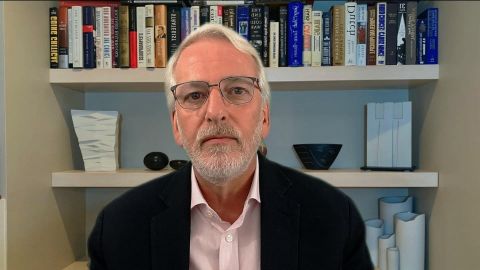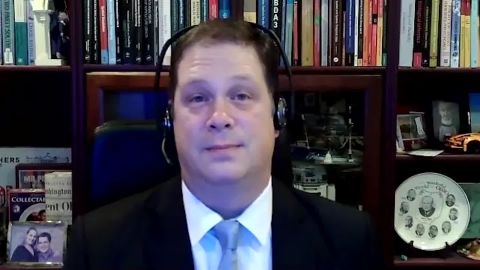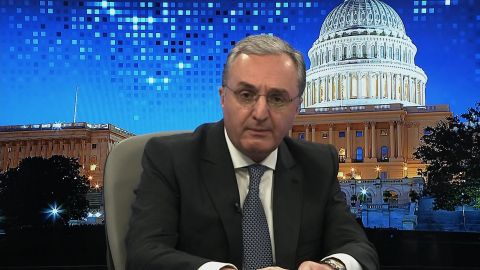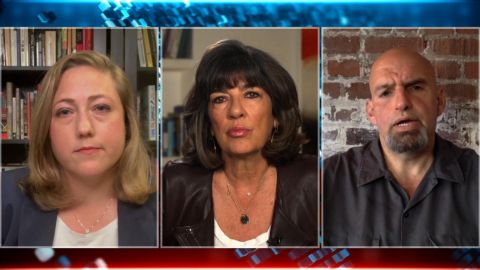Read Transcript EXPAND
CHRISTIANE AMANPOUR: Now, we have spoken about the competing visions in the race for the White House. Donald Trump’s 2016 victory shocked America and, in fact, the whole world, after polls consistently showed him trailing Hillary Clinton. Polls again, as we have been discussing, have the Democratic candidate with a comfortable lead, but will they get it right this time? Sean Trende is a senior analyst for RealClearPolitics who’s been tracking the trends shaping 2020 and how polling has changed over the last four years. Here, he’s talking to our Hari Sreenivasan about his key takeaways as the clock ticks down.
(BEGIN VIDEOTAPE)
HARI SREENIVASAN: Christiane, thanks. Sean Trende, thanks for joining us. I’m not going to ask you about who’s leading right now, because I know polls are just a snapshot, and people should go vote regardless of whether they’re candidate is up or down. But I want to ask, do you think that last night’s debate is going to have any impact on these?
SEAN TRENDE, SENIOR ELECTIONS ANALYST, REALCLEARPOLITICS: I think, if it does have an impact, it’ll be pretty moderate. I think there are some conservative voters in the U.S. who were kind of looking for permission to vote for Donald Trump, if you will. They’re inclined to vote for Republicans, but because of President Trump’s behavior, having a normalish debate from him probably helps him. But, overall, I don’t think we will see any major movement as a result.
SREENIVASAN: Is there a trend line that you have seen, not just about the about who’s leading and who’s not, but, say, for example, the rest of the questions in the poll, which I think are much more fascinating to me, about issues that seem persistent?
TRENDE: Yes, we look at the traditional question. People vote their pocketbooks. There’s the line going back, Bill Clinton’s 1992 campaign, “It’s the economy, stupid,” And look to see how people perform there traditionally. And then, actually, surprisingly, Donald Trump holds up fairly well. He typically leads Joe Biden on who’s best for the economy. But this cycle is a little different. We want to see who leads on the handling of coronavirus. And, in that case, it’s usually Joe Biden who’s leading the president. There are other issues, like health care and things like that, that typically voters say don’t matter as much. Typically, Joe Biden leads on these other issues as well.
SREENIVASAN: So, where were we in 2016 compared to now? I know it’s a different landscape, because there was not a pandemic facing either Donald Trump or Hillary Clinton at that time.
TRENDE: Yes, I mean, I want to be cautious with the 2016 comparisons, especially given what I’m about to tell people. But, in 2016, Donald Trump was not an incumbent. And so the machinations of the functioning of the election was a little bit different. But the polls actually looked a lot in 2016 like they look right now, especially at the state polls. Clinton had blown up a big lead after the “Access Hollywood” tape dropped, and then it was just kind of like trending, gradually tightening, and that’s what we’re seeing right now. And if you look at the states, they’re almost exactly where they were in 2016.
SREENIVASAN: So, that leads to a natural question. What did the polls get wrong last time ,and how are they different today?
TRENDE: We hope we know the answer to that. Part of it is easy. People convinced themselves that the Upper Midwest wasn’t competitive. And they stopped polling. We didn’t get a lot of polls from states like Wisconsin and Michigan and Minnesota in the closing days. We think the issue was that they weren’t getting enough whites without college degrees in the sample. And so — and that’s a problem, because that was Donald Trump’s strongest demographic group. And they are the most — they’re a massive demographic group in kind of — in these key states of Michigan, Wisconsin, so forth. So, pollsters have been working really hard to try to get more of these voters in their sample. We’re a little nervous, because, in 2018, the poll said we were supposed to have Democratic governors in Ohio and Iowa, and that didn’t pan out. We were supposed to have Democratic senators in Missouri and Indiana, and that didn’t pan out. So, there’s some nervousness here. But I think at least some of the error in 2016 was fixed.
SREENIVASAN: So, how do pollsters correct for that? And how do we know? I mean, is — do just try to make sure that you’re including that many more people of whatever category in your phone survey? Because there’s always the concern, well, the people who might support the president might not really like talking to pollsters.
TRENDE: And that’s something that you can’t do anything about that, that last scenario. And that’s what makes us nervous. Donald Trump voters are characterized by low levels of social trust. And you can easily see how that could manifest, even with every demographic characteristic controlled for, not talking to pollsters. With that said, to answer the question more directly, you know what share the population white voters and whites without college degrees and African- American voters make. And so when you get your overall sample, you do what’s called weighting the respondents. If you only have 8 percent African-Americans in your sample, and you know the population as a whole is 16 percent, you essentially count those African-American respondents twice. You wake them up to their population average.
SREENIVASAN: There’s also the fact that there’s the popular vote, which the polls might predict accurately, and then there’s the Electoral College, which is a whole different beast.
TRENDE: Absolutely. And we know what happened in 2016. We know what happened in 2000. And if you look at the polls, it suggests that the split between the state that gives Joe Biden or Donald Trump electoral vote 270, and the popular vote is going to be about three or four points this time. So, when you see Joe Biden with a seven- or eight-point lead, I just always mentally subtract four points from it. And so it’s really a three- or four- point lead right now. And that puts things in perspective.
SREENIVASAN: Is there still an undecided voter left in America? Because it seems like, if you like the president, you love him by now, if you didn’t like the president in 2016, you really don’t like him now.
TRENDE: Well, if you haven’t made your mind up about Donald Trump by now, I don’t know what’s going to help you choose. I mean, the last four years have, if absolutely nothing else, been eventful I — we look at the polls. And at this point in 2016, Donald Trump and Hillary Clinton accounted for about 85 percent of voters, and there were a large number of undecided. Some of those went to third parties. If you look at it today, it’s more like 93 percent of voters are voting for Donald Trump or Joe Biden. So, we really are talking about a very small pool of undecided voters at this point.
SREENIVASAN: What do you think is the driving factor in the resiliency of the president? Because what’s impressive, regardless of where you are politically, is how consistent his support has been. I mean, it’s barely wavered lower, and then maybe back to where it was, over the four years.
TRENDE: Yes, during his first year of office, he saw it dip down into the high 30s. But it came back in 2018. He’s been pretty much the most stable job approval president ever. It’s tracked between 42 and 46 percent ever since. I think there are just — there’s people who just like Donald Trump. And I don’t know how else to explain it. I think part of it is, we’re in a very polarized time. So, if you’re Republican, you start out liking Republicans, and if you’re Democrat, you don’t. Donald Trump famously had no what we call a honeymoon period. His job approval started at like 47 percent, kind of just outside his normal range, whereas most presidents will get up above 50 percent and even into the 60s for their first couple months in office. So it’s just been an unusual presidency, but perhaps it’s a sign of the times.
SREENIVASAN: Is there — is it accurate when people say, oh, that poll comes out, well, that’s a right-leaning poll, oh, this is a left-leaning poll? They’re not really — most people don’t — are not pollsters. They don’t have to read the fine print on exactly who was surveyed. We don’t know which 1,200 people were phoned, right? But is there implicit bias inside the polling systems that exist today?
TRENDE: There are some pollsters who, for whatever reason, when they take polls — some of them, we know exactly why they take a poll and it has a Republican lean or Democratic lean, because they’re companies that are affiliated with the Republican or Democratic Party, Trafalgar on the right and PPP on the left. For the most part, though, I think pollsters try to get it as right as they can, because they’re putting their reputation on the line. And so whether it’s the CNN poll, or the FOX poll, or the MSNBC poll, they’re trying to inform their viewers. And I don’t think you can dismiss any of those polls based on the label, unless it comes from an outfit that is particularly devoted to one party or the other.
SREENIVASAN: And if we also included cell phone numbers in this now? Because different markets, some people are cutting the cord, they don’t have copper service lines that they’re paying for anymore.
TRENDE: It is a huge problem, there’s no doubt about it, that we have cell phone — a lot of cell phone-only households now, because, under federal law, if you have you know the robo-dialing polls, where it’s not a person, it’s just a computer that asks you the questions and you punch it on, you can’t do that with cell phones. It’s something that goes back to the days when people paid by the minute, and so they passed a law to protect people from having to listen to robo- calls and waste their minutes. And now there’s just no constituency for letting the robo-callers call your cell phone. Anyway, it’s a problem. And there’s no easy way around it. Live interview polls are very expensive, so, generally, only the big networks conduct them. You know, people do the best they can.
SREENIVASAN: You recently wrote a couple of articles, Donald Trump’s path to victory and what a Biden win would look like. Just kind of summarize your main takeaways there.
TRENDE: Yes. So, a Biden win is the easy piece to write, because it’s basically the polls are correct. And if you go back to like 1998, there’s really not much of a bias to the polls. Now, in any given year, there can be a substantial bias one way or the other. But, overall, the polls are accurate. So, there’s probably going to be some sort of house effect. In 2012, people don’t remember it, but there was actually a bias in the polls. It was towards the Republicans. Barack Obama outperformed the polls by about two or three points. No one cared, because the polls that said Barack Obama would win. So, in that way, the 2016 error was typical. So you should expect the polls will be unbiased, but know that they can be off two or three points in either direction. So, Biden could outperform his already kind of substantial polling lead. For Donald Trump, it’s a little bit trickier. When I wrote — when I wrote the piece, his job approval was about 43 percent. And, typically, incumbent presidents get their job approval plus a point or two. And so I said, if he can get his job approval back up to 46 percent by Election Day, he’d actually have a pretty good shot. You would expect him to lose the popular vote by three or four points, which, for him, probably translates to an Electoral College victory. But we have seen his job approval stagnate about 44.5 percent, 45 percent. And I don’t think that’s enough for him to get it done, unless something happens over the next week or two — I mean, we have got now, I think, 10 days to improve his job approval — I think he’s going to have a tough time winning.
SREENIVASAN: What — you mentioned 2018. And what does that tell you about 2020, if the predictions were that there should have been more of a Democratic blue wave coming through?
TRENDE: It’s something that makes us a little bit nervous. I mentioned the polls in the Upper Midwest, but also Florida, which is — if you go back to 1992, and add up all the votes for Republican presidents and all the votes for Democratic presidents in the state of Florida, the gap is 10,000 votes. Like, it is that close. And so we kind of look to it as the kind of perennial swing state. But, in 2018, I don’t think Ron DeSantis led in a single poll over Andrew Gillum, and yet he is now the governor. Rick Scott did lead in a couple polls over Bill Nelson, but it wasn’t many, and he is now the senator. So there was a Democratic bias in the polls in 2018, no doubt about it. Will it repeat in 2020? We don’t know. But we have to be aware of the possibility.
SREENIVASAN: I’m going to ask also, given the huge surge in not just interest, but in actual early voting and mail-in balloting, how do you capture that cross-section of the audience?
TRENDE: So, there’s a couple ways you can do it. One way is that some states let you know who voted. And so some of these pollsters aren’t randomly dialing. They are selecting people from a list, a published list of voters and sampling from that list. And so, in some of these states, you can match that with people who have voted early. And that’s actually great, because you know these people have voted. You ask them who they voted for. You don’t have to guess at what that electorate looks like. Other states, the data aren’t quite as good. And that’s where it becomes a little bit tricky. One of the interesting things is that there will typically be more people who say they have already voted than actually already voted. People aren’t truthful. And so that’s just one of those vagaries of polling you try to deal with.
SREENIVASAN: Do Biden supporters have reason to be concerned, considering — or do Trump supporters have reason to say, you know what, this happened last time, he’s sort of the comeback kid?
TRENDE: Yes, I mean, you can’t dismiss what happened last time. And, like I said, you can’t dismiss what happened in 2012, where the polls were actually off by two or three points, just in the different — in the different direction. So you have to acknowledge the possibility that these things can happen. But, like I said, the error can be in either direction. We could have polls showing Joe Biden up by seven points and then, on Election Day, he wins by 10 or 11. You cannot predict which direction poll errors go.
SREENIVASAN: Let’s talk a little bit about the Senate race, because, in a way, people have made up their minds about the president, and that’s not going to have nearly as much of a margin of change as what could happen in the Senate in technically 50 different places, right? So, how do we — heading in now to the election, what are the Senate races that you’re most intrigued by?
TRENDE: There are a lot of interesting Senate races, but we can — we can kind of clump — put a clump in of seats we think are going to change. And they would give Democrats two seats, one short of a majority. Then there’s a cluster of races that, if things get really bad for Republicans, they could lose, but they probably lost the majority before those seats flip. The majority-making seats are most likely Iowa and North Carolina, two very close Senate races. Right now, in our average, we have the Democrats ahead in each of them by two points. But they also have been closing in our averages. So…
SREENIVASAN: Is that within the margin of error?
TRENDE: Well within the margin of error, yes. So, control the Senate really could — I mean, unless the polls have a systemic bias, and Joe Biden wins by 10 points, then I say, yes, Democrats could get 54, 55 seats. But if we’re in this range of Joe Biden winning by six to eight points, those two seats are going to be very, very tight. So, in North Carolina, Thom Tillis and Cal Cunningham are neck and neck in a race. Thom Tillis is trying to get reelected for the first time. It’s the same story in Iowa. Joni Ernst was elected in 2014 to replace Tom Harkin. She is in a very, very close race for that seat.
SREENIVASAN: And in North Carolina, this is after a sexting scandal with somebody who wasn’t Mr. Cunningham’s wife.
TRENDE: Yes, that’s right. This was a race where it kind of looked like maybe like Cal Cunningham was getting some distance from Tillis, but ever since that scandal broke, there’s been a hard break towards Tillis in the polls. He’s still not leading in our averages, but it is much more competitive than it looked a few days — a few weeks ago.
SREENIVASAN: What are you watching for in the last week?
TRENDE: I watch President Trump’s job approval more than anything else, because if we do see a late break among a small number of undecided voters — I think that’s where it turns up first. People decide, OK, I like the job he’s doing. Then they make the decision that they’re going to vote for him or against him. I’m paying very close attention to those two Senate races in Iowa and North Carolina, because I do think they’re the majority-makers, and just trying to keep my sanity, along with the rest of America. Sean Trende, RealClearPolitics, thanks so much.
TRENDE: Thank you.
About This Episode EXPAND
Sarah Longwell and John Fetterman react to Thursday’s debate. Armenia’s Minister of Foreign Affairs discusses violence between his country and Azerbaijan. Former U.S. ambassador to NATO Ivo Daalder provides wider geopolitical context to the conflict. Political analyst Sean Trende discusses the 2020 presidential election polls and whether or not Americans can trust them.
LEARN MORE



